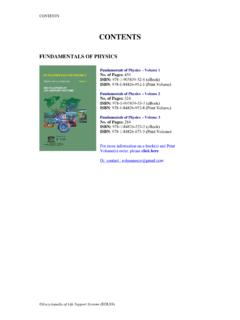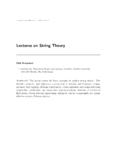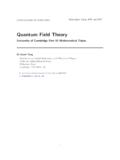Transcription of Review Conformal Symmetry in Field Theory and in Quantum ...
1 ReviewConformal Symmetry in Field Theoryand in Quantum GravityLes aw Rachwa 11 Instituto de F sica, Universidade de Bras lia, 70910-900, Bras lia, DF, Brazil; Editor: nameReceived: 29 August 2018; Accepted: 9 November 2018; Published: 15 November 2018 Abstract: Conformal Symmetry always played an important role in Field Theory (both quantumand classical) and in gravity. We present construction of Quantum Conformal gravity and discussits features regarding scattering amplitudes and Quantum effective action. First, the long andcomplicated story of UV-divergences is the development of UV-finite higherderivative (or non-local) gravitational Theory , all problems with infinities and spacetime singularitiesare solved.
2 Moreover, the non-local Quantum Conformal Theory reveals itself to be ghost-free, so theunitarity of the Theory is safe. After the construction of UV-finite Theory , we focused on makingit manifestly conformally invariant using the dilaton trick. We also argue that in this class oftheories Conformal anomaly vanishes by fine-tuning the couplings. As applications of this Theory ,the constraints of the Conformal Symmetry on the form of the effective action and on the scatteringamplitudes are shown. We also remark about the preservation of the unitarity bound for , the old model of Conformal supergravity by Fradkin and Tseytlin is briefly : Quantum gravity, Conformal gravity, Quantum Field Theory , non-local gravity,super-renormalizable gravity, UV-finite gravity, Conformal anomaly, scattering amplitudes, Conformal Symmetry , Conformal supergravity1.
3 IntroductionFrom the beginning of research on theories enjoying invariance under local spacetime-dependenttransformations, Conformal Symmetry played a pivotal role first introduced by Weyl related changesof meters to measure distances (and also due to relativity changes of periods of clocks to measure timeintervals). Weyl thought of transformations changing the scale and quite boldly he considered themnot only in global version (where the parameters of the transformations are constant), but also in local(where the parameters depend both on space location and time). Then, he also understood that justrescaling transformationsds ds =e ds(1)(which form abelian group) after making them local gives rise to full Conformal group oftransformations, where only angles remain invariant, but the sizes, magnitudes and scalar productsbetween vectors change.
4 These primordial considerations were done within a set of ideas thatconformal transformations are the symmetries of fully relativistic consistent classical Theory , Einstein beat the Weyl Theory with his famous second argument aboutradiating atoms in various gravitational fields. With the triumph of Einsteinian relativistic theoryof gravitation (confirmed by the measurements done during the solar eclipse in 1917), whichincludes only symmetries with respect to diffeomorphism transformations, Weyl s Conformal theoryof gravitation was relegated and treated as non-physical.
5 However, the ideas of scale transformationsseeded by Weyl were revealed to be very fruitful in the development of local gauge theories. Thechange was that the transformations were done in the internal space, not in spacetime, and thatthey were imaginary rescalings or simply complex phase transformations compared to the ones inEqn. (1). This with London equations started a revolution leading toU(1)gauge Theory known [hep-th] 16 Dec 20182 of 44electrodynamics and even to non-abelian generalizations as embodied by Yang Mills (YM) , the origin of the German word gauge used now so often in Field Theory is clear andundoubtedly points to different real scales used for measurement of distances, like for examplebetween two rails in rail seemed that in the classical world Conformal Symmetry had to play a rather small role andwas not used in relation to classical gravity.
6 The time for Conformal methods in general relativity(GR) had to come later, for example when the research on black holes and their spacetime causalstructure culminated in the golden age of classical gravitation in the 1960s and 1970s. In a differentvein, Conformal invariance and Conformal Symmetry started to become appreciated a lot also inthe era of modern Quantum Field theories. With the development of the renormalization methodsin perturbative Quantum Field Theory models, Conformal Symmetry became an indispensable toolfor every particle physicist. Moreover, the relation between Renormalization Group (RG) flow andConformal Field Theories (CFT) and Conformal anomalies was found to be even more tight due to theunderstanding of physics at and near a fixed point of RG.
7 The application of Conformal considerationsin Field Theory was also beautifully unified with gravitational (spacetime) considerations throughAdS/CFT duality. Now, every modern theoretician knows that Conformal tools are both usefuland enlightening for investigations both in gravity and in Field Theory . In the advent of biggerunderstanding of Conformal Symmetry , we could come back and refresh interest in the original Weylgravity, where the original Conformal Symmetry is taken as a basis for the Theory of gravitationalinteractions. However, on the Quantum level, we meet several serious obstacles.
8 Actually, one canfind that there is a very special relation between Quantum physics and Conformal Symmetry , whichis not enjoyed by any other known symmetries of Nature, nor by other gauge symmetries used get effective Field theories (EFT), we typically need to perform a very abstract mathematicalprocedure called quantization. It takes a classical action of a Theory and enforces the rules ofquantum mechanics. In all perturbative approaches, the result of this artificial procedure done only bytheoreticians (because the Nature is already always Quantum !) is expressed as a perturbative series insome small parameter.
9 Typically, this is a Planck constant hmultiplying some couplings of the theoryand this is equivalent to the loop expansion. It is necessary here to distinguish the two possiblemeanings of EFT: they appear either as a low-energy effective description (in powers of a smalllength scale) or as a Quantum effective description (in powers of Planck constant). Now, the questionarises of how to find effective actions of a given model at any loop order. By the knowledge andexperience gained in some ordinary QFT, this is a very complicated process and the effective actionsat higher loops are non-local functionals of fields, and of covariant differential operators and typicallywith infinite number of terms hence almost impossible to handle exactly without employing anyapproximations.
10 One may think that the gauge symmetries of the Theory (if they are non-anomalouson the Quantum level) may help in constraining the number of terms in the effective action. However,since in EFT, we do not have to obey the renormalizability conditions at loop orders, the numberof terms is still infinite, and all of them can be written in a gauge covariant fashion. In the act ofresignation, we may contemplate the details of the procedure of quantization transforming someclassical action functionals into much more complicated non-local functionals at one-loop, two-loopand higher loop levels. Someone may think about taking some shortcuts and for example consideringtwo-loop effective action as a result of quantization applied to one-loop level of already quantizedone-loop level effective action.
![arXiv:0706.3639v1 [cs.AI] 25 Jun 2007](/cache/preview/4/1/3/9/3/1/4/b/thumb-4139314b93ef86b7b4c2d05ebcc88e46.jpg)

![arXiv:1301.3781v3 [cs.CL] 7 Sep 2013](/cache/preview/4/d/5/0/4/3/4/0/thumb-4d504340120163c0bdf3f4678d8d217f.jpg)
![@google.com arXiv:1609.03499v2 [cs.SD] 19 Sep 2016](/cache/preview/c/3/4/9/4/6/9/b/thumb-c349469b499107d21e221f2ac908f8b2.jpg)









